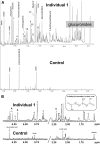Squalene Synthase Deficiency: Clinical, Biochemical, and Molecular Characterization of a Defect in Cholesterol Biosynthesis
- PMID: 29909962
- PMCID: PMC6037199
- DOI: 10.1016/j.ajhg.2018.05.004
Squalene Synthase Deficiency: Clinical, Biochemical, and Molecular Characterization of a Defect in Cholesterol Biosynthesis
Abstract
Mendelian disorders of cholesterol biosynthesis typically result in multi-system clinical phenotypes, underlining the importance of cholesterol in embryogenesis and development. FDFT1 encodes for an evolutionarily conserved enzyme, squalene synthase (SS, farnesyl-pyrophosphate farnesyl-transferase 1), which catalyzes the first committed step in cholesterol biosynthesis. We report three individuals with profound developmental delay, brain abnormalities, 2-3 syndactyly of the toes, and facial dysmorphisms, resembling Smith-Lemli-Opitz syndrome, the most common cholesterol biogenesis defect. The metabolite profile in plasma and urine suggested that their defect was at the level of squalene synthase. Whole-exome sequencing was used to identify recessive disease-causing variants in FDFT1. Functional characterization of one variant demonstrated a partial splicing defect and altered promoter and/or enhancer activity, reflecting essential mechanisms for regulating cholesterol biosynthesis/uptake in steady state.
Keywords: FDFT1; cholesterol biosynthesis; dysmorphism; syndactyly.
Crown Copyright © 2018. Published by Elsevier Inc. All rights reserved.
Figures




Similar articles
-
Roles of Farnesyl-Diphosphate Farnesyltransferase 1 in Tumour and Tumour Microenvironments.Cells. 2020 Oct 25;9(11):2352. doi: 10.3390/cells9112352. Cells. 2020. PMID: 33113804 Free PMC article. Review.
-
Regulation of cholesterol biosynthetic pathway in patients with the Smith-Lemli-Opitz syndrome.J Inherit Metab Dis. 2000 Jul;23(5):464-74. doi: 10.1023/a:1005660130109. J Inherit Metab Dis. 2000. PMID: 10947201
-
Radiographic features of the skeleton in disorders of post-squalene cholesterol biosynthesis.Pediatr Radiol. 2015 Jul;45(7):965-76. doi: 10.1007/s00247-014-3257-9. Epub 2015 Feb 3. Pediatr Radiol. 2015. PMID: 25646736 Review.
-
[Inborn error of cholesterol biosynthesis: Smith-Lemli-Opitz syndrome].Orv Hetil. 2015 Oct 18;156(42):1695-702. doi: 10.1556/650.2015.30256. Orv Hetil. 2015. PMID: 26551309 Review. Hungarian.
-
A case of Smith-Lemli-Opitz Syndrome, defect of cholesterol biosynthesis.Int J Immunopathol Pharmacol. 2006 Apr-Jun;19(2):439-42. doi: 10.1177/039463200601900220. Int J Immunopathol Pharmacol. 2006. PMID: 16831310
Cited by
-
Roles of Farnesyl-Diphosphate Farnesyltransferase 1 in Tumour and Tumour Microenvironments.Cells. 2020 Oct 25;9(11):2352. doi: 10.3390/cells9112352. Cells. 2020. PMID: 33113804 Free PMC article. Review.
-
Identification of novel molecules and pathways associated with fascin actin‑bundling protein 1 in laryngeal squamous cell carcinoma through comprehensive transcriptome analysis.Int J Mol Med. 2024 Apr;53(4):39. doi: 10.3892/ijmm.2024.5363. Epub 2024 Mar 1. Int J Mol Med. 2024. PMID: 38426543 Free PMC article.
-
Linoleic acid inhibits in vitro function of human and murine dendritic cells, CD4+T cells and retinal pigment epithelial cells.Graefes Arch Clin Exp Ophthalmol. 2021 Apr;259(4):987-998. doi: 10.1007/s00417-020-04972-6. Epub 2020 Oct 20. Graefes Arch Clin Exp Ophthalmol. 2021. PMID: 33079282
-
3β-Hydroxy-12-oleanen-27-oic Acid Exerts an Antiproliferative Effect on Human Colon Carcinoma HCT116 Cells via Targeting FDFT1.Int J Mol Sci. 2023 Oct 9;24(19):15020. doi: 10.3390/ijms241915020. Int J Mol Sci. 2023. PMID: 37834468 Free PMC article.
-
Unveiling the Therapeutic Potential of Squalene Synthase: Deciphering Its Biochemical Mechanism, Disease Implications, and Intriguing Ties to Ferroptosis.Cancers (Basel). 2023 Jul 22;15(14):3731. doi: 10.3390/cancers15143731. Cancers (Basel). 2023. PMID: 37509391 Free PMC article. Review.
References
-
- Waterham H.R. Defects of cholesterol biosynthesis. FEBS Lett. 2006;580:5442–5449. - PubMed
-
- Schechter I., Conrad D.G., Hart I., Berger R.C., McKenzie T.L., Bleskan J., Patterson D. Localization of the squalene synthase gene (FDFT1) to human chromosome 8p22-p23.1. Genomics. 1994;20:116–118. - PubMed
-
- Do R., Kiss R.S., Gaudet D., Engert J.C. Squalene synthase: a critical enzyme in the cholesterol biosynthesis pathway. Clin. Genet. 2009;75:19–29. - PubMed
-
- Jemal M., Ouyang Z. Gas chromatography-mass spectrometric method for quantitative determination in human urine of dicarboxylic (dioic) acids produced in the body as a consequence of cholesterol biosynthesis inhibition. J. Chromatogr. B Biomed. Sci. Appl. 1998;709:233–241. - PubMed
-
- Vaidya S., Bostedor R., Kurtz M.M., Bergstrom J.D., Bansal V.S. Massive production of farnesol-derived dicarboxylic acids in mice treated with the squalene synthase inhibitor zaragozic acid A. Arch. Biochem. Biophys. 1998;355:84–92. - PubMed
Publication types
MeSH terms
Substances
LinkOut - more resources
Full Text Sources
Other Literature Sources
Medical
Molecular Biology Databases

